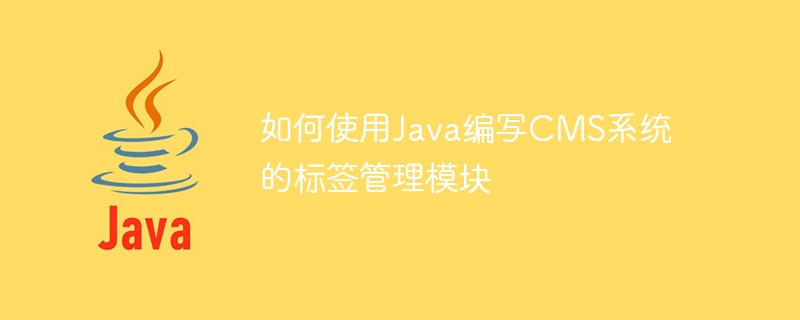Home >Java >javaTutorial >How to use Java to write the tag management module of the CMS system
How to use Java to write the tag management module of the CMS system
- 王林Original
- 2023-08-09 15:12:271241browse

How to use Java to write the tag management module of a CMS system
In a modern content management system (CMS), the tag management module is a key component. It helps users categorize and organize content in the system. This article will introduce how to use Java to write a simple tag management module for a CMS system and provide code examples.
- Database design
First, we need to design a database to store tag information. We can create a table called "tags" with the following fields: - id: The unique identifier (primary key) of the tag
- name: The name of the tag
- Data access layer
Next, we need to implement the addition, deletion, modification and query operations of tag data in the data access layer. We can create a class called "TagDAO" and define the following method in it:
public interface TagDAO {
List<Tag> getAllTags() throws DAOException;
Tag getTagById(int id) throws DAOException;
void addTag(Tag tag) throws DAOException;
void updateTag(Tag tag) throws DAOException;
void deleteTag(Tag tag) throws DAOException;
}Then, we can create a class called "TagDAOImpl" to implement this interface and use JDBC to interact with the database. The following is a simple example:
public class TagDAOImpl implements TagDAO {
// 数据库连接相关代码
@Override
public List<Tag> getAllTags() throws DAOException {
// 实现获取所有标签的逻辑
}
@Override
public Tag getTagById(int id) throws DAOException {
// 实现根据id获取标签的逻辑
}
@Override
public void addTag(Tag tag) throws DAOException {
// 实现添加标签的逻辑
}
@Override
public void updateTag(Tag tag) throws DAOException {
// 实现更新标签的逻辑
}
@Override
public void deleteTag(Tag tag) throws DAOException {
// 实现删除标签的逻辑
}
}- Business logic layer
In the business logic layer, we can create a class named "TagService" to handle business logic related to tag management . Here is a simple example:
public class TagService {
private TagDAO tagDAO;
// 依赖注入TagDAO实例
public List<Tag> getAllTags() {
try {
return tagDAO.getAllTags();
} catch (DAOException e) {
// 处理异常
}
}
public Tag getTagById(int id) {
try {
return tagDAO.getTagById(id);
} catch (DAOException e) {
// 处理异常
}
}
public void addTag(Tag tag) {
try {
tagDAO.addTag(tag);
} catch (DAOException e) {
// 处理异常
}
}
public void updateTag(Tag tag) {
try {
tagDAO.updateTag(tag);
} catch (DAOException e) {
// 处理异常
}
}
public void deleteTag(Tag tag) {
try {
tagDAO.deleteTag(tag);
} catch (DAOException e) {
// 处理异常
}
}
}- Controller Layer
Finally, we can create a class called "TagController" to handle user requests and map them to the appropriate business logic. Here is a simple example:
public class TagController {
private TagService tagService;
// 依赖注入TagService实例
public void getAllTags(HttpServletRequest request, HttpServletResponse response) {
List<Tag> tags = tagService.getAllTags();
// 处理结果,例如将标签列表传递给视图进行渲染
}
public void getTagById(HttpServletRequest request, HttpServletResponse response) {
int id = Integer.parseInt(request.getParameter("id"));
Tag tag = tagService.getTagById(id);
// 处理结果,例如将标签对象传递给视图进行渲染
}
public void addTag(HttpServletRequest request, HttpServletResponse response) {
String name = request.getParameter("name");
Tag tag = new Tag(name);
tagService.addTag(tag);
// 处理结果,例如重定向到标签列表页面
}
public void updateTag(HttpServletRequest request, HttpServletResponse response) {
int id = Integer.parseInt(request.getParameter("id"));
String name = request.getParameter("name");
Tag tag = new Tag(id, name);
tagService.updateTag(tag);
// 处理结果,例如重定向到标签列表页面
}
public void deleteTag(HttpServletRequest request, HttpServletResponse response) {
int id = Integer.parseInt(request.getParameter("id"));
Tag tag = new Tag(id);
tagService.deleteTag(tag);
// 处理结果,例如重定向到标签列表页面
}
}In the above example, we have used basic Java Servlet technology to handle user requests and forward them to the appropriate controller method. The controller method will call the corresponding service method to process the business logic and return the results to the user.
Summary
Through the above steps, we can use Java to write a simple tag management module of the CMS system. In actual applications, you may need to further expand and improve the functions of this module according to your own needs. I wish you success in writing!
The above is the detailed content of How to use Java to write the tag management module of the CMS system. For more information, please follow other related articles on the PHP Chinese website!
Related articles
See more- Download the net.mindview.util package in the 2018 New Java Programming Thoughts Fourth Edition
- How to develop a single-page CMS system using PHP
- How to use PHP to implement the logging function of CMS system
- How to use Java to develop the article publishing function of CMS system
- How to use Python to build the message push function of CMS system

